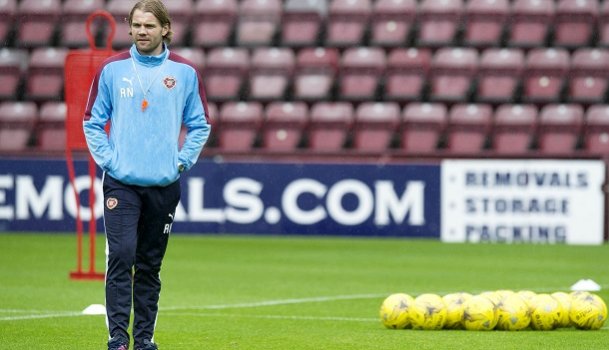In the first of a weekly feature, Craig Cairns takes a look at how some tactical changes in the SPFL are paying dividends this season.
Gomis and Buaben switch roles at Tynecastle
For two players who seem to have some sort of intuitive understanding, it really shouldn't be a surprise that the pair are able to swap roles without losing any of their effectiveness. Normally, in Hearts' 4-2-3-1 system, Morgaro Gomis stays back while Prince Buaben ventures forward to support the attack. However, the latter has been struggling with injuries of late, so manager Robbie Neilson instead encouraged his partner-in-crime to get forward against Partick Thistle.
The result was a man-of-the-match worthy performance from Gomis, whose dynamism and tenacity enabled Hearts to continually keep a high tempo, eventually suffocating Thistle into submission, while Buaben, with his added physical presence, was an effective screener in front of the back four. The pair have done so well so far that the team hasn't even felt the loss of Miguel Pallardo, arguably the most impressive player in the Hearts ranks last season.
Change in style is paying off mightily for Rangers
Two flying full-backs, a target-man who is just as comfortable dropping deep to link play, pace and goals on the wings, and a central midfield that possess enough creativity and industry to see them through most matches have become the new norm at Rangers.
The style and approach are completely different at Ibrox this season. Of the 20 goals they have scored so far, only two are the result of high balls into the box and none have involved headers.
At first glance, Martyn Waghorn may look like your typical old-fashioned battering ram but, even though he has deployed his strength to hold up play when required, he is at his best when dropping deep to link with the midfield or else making runs in behind the defence and looking for the ball into feet. He alone, as the focal point of their new-look attack, marks a definitive departure from the previous approach at Rangers.
Danger from wide areas key for Ross County
Jim McIntyre sets up his Ross County side with two hard-working finishers, flanked by two wingers getting support from their full-backs, meaning that, since McIntyre’s appointment, 24 of their 51 league goals have come as a result of crosses into the box. This number rises to 28 when corners are included. In Saturday’s rout of Kilmarnock, debutant Jonathan Franks scored and Jamie Reckord provided an assist, displaying further that the County’s goals are coming largely from wide areas. In fact, of the 33 goals scored since their upturn in fortunes in February, 22 have been netted or assisted by a winger or a full-back.
Michael Gardyne was key to the imperious form that saw County steer clear of relegation last season and has been just as vital in their more recent run of form. After a slow start to his Staggies return – just one goal and two assists in 13 matches – Gardyne has since been involved in 17 of his side’s last 33 league goals, including all four on Saturday.
Celtic trial Rogic at defensive midfield
Celtic's Australian midfielder Tom Rogic has seen his game time increase quite dramatically so far this season as manager Ronny Deila has not been hesitant to give him a chance in the starting XI. For the most part, this has been as the central attacking midfielder in the supporting triumvirate in Celtic's 4-2-3-1 system. The downside to such a move is that, when the Norwegian is also fit, it means Stefan Johansen is then forced back into the more defensive role as part of the double pivot. Johansen in that position is a fine player, but Johansen in the No 10 role is Scotland's player of the year, so there is a drop off in production to consider.
Even though Johansen was rested against Dundee United, Rogic was utilised further back, and impressed enough that Deila might consider switching the two when they feature in the same team. Rogic's composure on the ball allowed him to shine in Celtic's 3-1 win, despite going up against a determined United midfield with a point to prove.
Dynamic full-backs a difference maker for Aberdeen
Perhaps coincidentally, two of the more astute tacticians in the Ladbrokes Premiership started with respective systems that would, for large parts, cancel each other out. Derek McInnes deployed a front two for the first time this season, though both Adam Rooney and David Goodwillie took turns to drop and link the play, while Paul Hartley went with a back three for the first time. Whether intended or not, for the first half at least, it reduced Aberdeen to being a threat mainly from set-pieces.
The knock-on effect was for Kenny McLean to take up a deeper role after a blistering start to his campaign – the midfielder has netted four goals from the attacking midfield position this season. Even though he wasn’t as able to make his mark on the game in attacking areas, he and Aberdeen remained patient, knowing they possessed the ingenuity to create something as the match progressed.
They did, through a moment of brilliance from Jonny Hayes on the right wing and a lethal header from Rooney. What’s interesting about this goal relative to the way Aberdeen play, however, is the positions of the Aberdeen full-backs. Graeme Shinnie, in a central midfield area, passes the ball to Shay Logan in the centre circle before the ball is fed out wide. When the goal is scored, both full-backs are in the box. Shinnie also almost converted a Niall McGinn cross later in the match when making a near-post run.
Competent attacking full-backs are crucial in modern football and we are seeing this increasingly deployed successfully by some of the top managers in the country.





.png)












